In General
.
No single factor can be used to conclusively judge
the age of a deer in the field. The picture at right illustrates the
main indicators that should be evaluated overall to get a good estimate
for a buck. The individual indicators will often vary a little from one
region of Texas to the next, and sometimes even within an individual
herd. If you can view known age bucks (ear tagged as fawns) in the area,
you can quickly get a better read on your local herd's distinguishing
characteristics. |
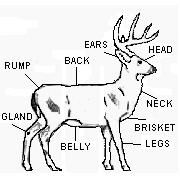 |
Using the Rack as
Indication of Age
.Notice
that the rack (antlers) is not depicted above as an indicator. While
some very general statements can be made about antler developmental
characteristics at certain ages of a buck, the rack is the least
reliable of any indicator. Remembering that these statements have MANY
EXCEPTIONS, antlers generally gain mass as the buck ages, generally get
darker as the buck ages, generally get wider as the buck ages, and will
get any nontypical points in it's genetics once the buck has matured
body wise. So, if a buck's antlers are wider than it's ears, dark in
color, seem thick in the beam circumferences, and have some nontypical
points, chances are good that the buck is mature. Because of the tooth
wear, a post mature buck's rack may actually start getting smaller from
year to year, but they usually keep the basal circumference, then it
will thin out quickly from there.
. |
 |
FAWN
.
Many people think they could never mistake a buck
fawn for a doe, but every year we have too many of those same folks wind
up doing just that. On the head, the pedicels (nubs) are the most
obvious clue. The ears will appear long, and the nose will appear short.
The body will be smaller than the adult doe's, but is bigger than a doe
fawn, so be careful. The legs look long and skinny, and the gait is
usually frisky, often frolicking. The tarsal glands will be small and
snow white. Does seldom travel alone, so give it a few minutes to see if
more deer show up for comparison. I've seen many buck fawns by
themselves. |
1 AND 1/2 YEARS
.At
this age, a buck looks like a doe with antlers. There will usually be a
slight dip in the back. They have a thin neck, no defined brisket, white
tarsal glands, and the belly line has a distinct up turn near the hams.
This gives it a greyhound racing dog sort of look. The legs still look
very long, and the gait is still pretty frisky. They will make unwanted
sexual advances on does, but are very timid in the presence of older
bucks. |
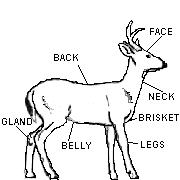 |
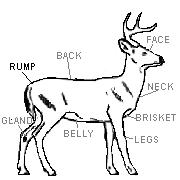 |
2 AND 1/2 YEARS
.At two and a
half, the animal starts bulking up a tad, but just a tad. The neck will
be bigger than a doe or yearling buck, but not much. The legs still look
fairly long. The face looks long and the skin tight. Eyes are near
perfectly round. Slightly developed brisket. The belly still has
somewhat of an upturn near the hams. The tarsal gland may have some
color to it. The rump appears squared off. |
3 AND 1/2 YEARS
.A
three and a half year old buck reminds me of a racehorse. They are
usually very lean muscle, and act ready for action. They may make rubs
and scrapes if no bigger bucks are present. The neck continues to get
bigger, making the head look shorter. The nose broadens, adding to this
illusion. The brisket is noticeable but not pronounced. Legs look the
right length now. The belly line is flat, with little up turn at the
rear. The tarsal gland will be dark in rut. Rump starts looking more
rounded at times and squared off at times, depending on stance. Back
line is flat. |
 |
 |
4 AND 1/2 YEARS
.
If fed well, a 4 and a half year old buck really
starts looking like a buck. The giveaways now are the back and belly
lines, and the head. On level ground, the back will have a slight dip
only, and the belly will not hang below the chest line. The head skin
will not look tight or loose, and the eyes almost round but not quite.
When one of these bucks walk, they still pick their feet up pretty good,
and the front knees won't look bent in when the deer is walking toward
you. Rump is getting pretty round, and tarsal glands will be black when
near or in rut. Nontypical points may start to show up now. |
5 AND 1/2 YEARS
.This
one gets hard to pass up. Unless your herd is well managed, most bucks
don't make it to this old, but you should actually let a buck get at
least 6 before you hammer them to achieve maximum antler potential. Now,
the eye will not be round anymore, it starts to look squinty. The
brisket is obvious where it joins the neck. The belly hangs even with
the chest or starts to hang below it a bit. They start walking knock
kneed somewhat. They seem more deliberate in their actions. Skin on head
starts looking a bit loose. Often have nontypical points. |
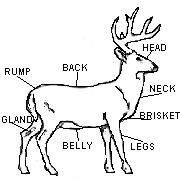 |
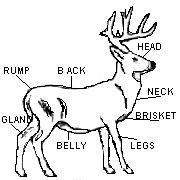 |
6 AND 1/2 YEARS
.
When a six year old walks out, it's usually pretty
obvious. All other deer pay attention. He is on top of his game and
knows it. Actions are very deliberate, like a big bull swaggering in.
The front knees bend in to handle the weight of the neck and rack. The
belly and back sags from years of fighting gravity. When relaxed, the
ears tend to droop down a bit for the same reason. The rump is well
rounded. The brisket obvious. Eyes are squinted; almost mean looking.
With good nutrition, all nontypical points in his genes will pop out
now. This is what you've waited for. TAKE HIM! |
PAST 6 AND 1/2 YEARS
.When a
buck's teeth wear out, somewhere between 7 and 9 years old in normal
habitat, antler and body conditions deteriorate. It is actually fairly
easy to mistake a 9 year old deer for a 3 or 4 year old deer. The
giveaway indicators though are the head, neck and rump. Also, muscle
tone. The head will continue to have the loose skin, and the eyes will
still be squinty, as in other mature bucks. The rump, however, will lose
mass, not appearing rounded anymore. It won't be smoothly squared off
like a young buck, either. It will be bony looking. The back may also be
bony looking. Even the shoulders won't look so well muscled, and the
neck certainly won't. I've noticed also that just like old men tend to
get gray hair, an old buck tends to look lighter in color than other
deer in the area. Not gray so much, but more of a lighter brown. Often,
the hair also appears course. |

.
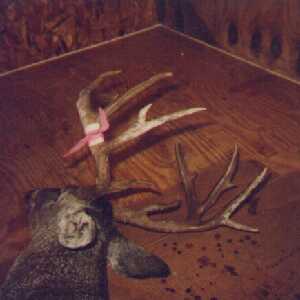 |

